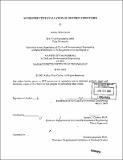Nondestructive evaluation of historic structures
Author(s)
Cecire, Ashley Skye, 1980-
DownloadFull printable version (6.950Mb)
Other Contributors
Massachusetts Institute of Technology. Dept. of Civil and Environmental Engineering.
Advisor
Jerome J. Connor.
Terms of use
Metadata
Show full item recordAbstract
This thesis is a requirement for the Master of Engineering (M.Eng) program in Civil and Environmental Engineering at the Massachusetts Institute of Technology. An historic structure may need restoration because it is structurally deficient, does not meet current building codes, is in need of renovation, or is being subjected to different loads than those that were originally intended. It is typically less expensive to simply replace a structure than to restore it, so the decision to restore is usually based on the historical significance of that structure to the owner. Often, because of the age of the structure, the structural plans no longer exist, and even if they are available, there is no guarantee that the structure was actually constructed according to plan. In order to avoid further damaging the structure with destructive testing, engineers use nondestructive evaluation (NDE) to determine the location of key structural elements, locate defects or anomalies in a material, and to determine the quality of a material. Although NDE usually is best applied to homogeneous materials, such as steel, it can be successfully applied to heterogeneous materials, such as masonry and concrete. NDE techniques such as Impulse Response, Impulse-Echo, Infrared Thermography, and Ground Penetrating Radar have been particularly successful for concrete and masonry structures. These have been used on a variety of structures, including St. Peter's Basilica in the Vatican; Malpaga Castle in Bergamo, Italy; Tower of the Orologio in Venice, Italy; historic bridges throughout the United States; and the former Hong Kong and Shanghai Banking Corporation in Shanghai, China. It is important to note that NDE techniques must be carefully used in order to obtain an accurate understanding of a structure. A skilled technician should interpret all NDE results. Typically, more than one NDE test will be needed to obtain all of the necessary information to accurately evaluate a structure.
Description
Thesis (M.Eng.)--Massachusetts Institute of Technology, Dept. of Civil and Environmental Engineering, 2003. Includes bibliographical references (p. 61-62).
Date issued
2003Department
Massachusetts Institute of Technology. Department of Civil and Environmental EngineeringPublisher
Massachusetts Institute of Technology
Keywords
Civil and Environmental Engineering.